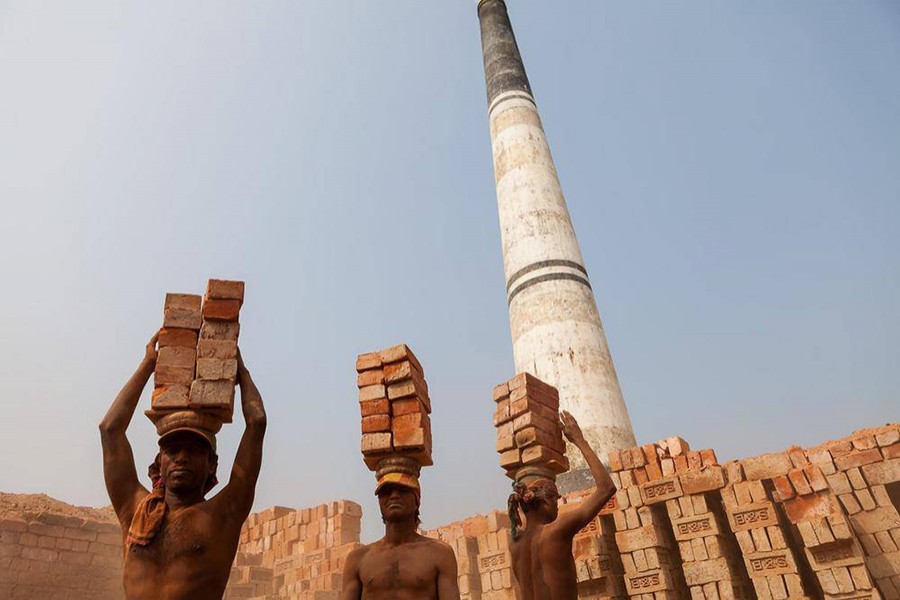Nearly 18 per cent of brick kilns use forest wood defying the existing law, causing adverse impacts on the environment and agriculture, according to a recent study.
Soil Resource Development Institute (SRDI) under the Ministry of Agriculture conducted the study on a total of 118 brick kilns in 86 upazilas of 48 districts across the country in 2017.
The study also revealed that chimneys of the surveyed brick kilns were not constructed as per government specifications.
Under the existing specifications, minimum required height of chimneys of brick kilns must be 120 feet.
There are some 6,900 brick kilns in the country which produce around 15 billion bricks annually.
The brickfields use about 1.27 billion cubic feet of topsoil, the study revealed. And use of high quality topsoil as raw material for bricks is a substantial environmental concern, which has led the government to prohibit previously profitable brick exports to India, it added.
A traditional brick kiln needs four acres of land to carry out its operation, according to sector insiders.
As per available information, around 20 million tonnes of carbon dioxide are emitted by conventional brick kilns, including 7,900 registered ones every year.
The country emits 80 million tonnes of carbon dioxide annually while 58 per cent of air pollution is created in Dhaka due to conventional brick kilns, it added.
Nearby farmers interviewed reported that brick kilns caused adverse effects on homestead plantation and crops, the study said. Farmers are sometimes forced to sell fertile topsoil of their croplands due to influential kiln owners, it also revealed.
However, most of the brick kilns are using coal as fuel.
The average distance between brick kilns and nearest homesteads is about ½ kilometre (570 metres) and the same between brick kilns and upazila headquarters is about 7.36 km.
But law prohibits people from setting up of brick kilns on homesteads and within one-kilometre from the boundaries thereof.
About 58 per cent of brick kilns surveyed were approved by the authority concerned while 18 per cent had no approval at all.
Brick kilns are located mostly nearer to densely populated areas which is a clear violation of the existing law.
However, Bangladesh Bricks Manufacturing Owners Association president Mizanur Rahman Babul claimed that no member of the association was currently using forest wood to make bricks.
If any brick kiln owner is involved with illegal practice defying the law, the government should take drastic action against them, he said.
The members of the association are using coal to make bricks, he added.
MA Matin, general secretary of Bangladesh Paribesh Andolan (Bapa), said use of forest wood in making bricks will lead to serious deforestation and create environmental hazards.
The government must take stern action against those responsible for this, he told the FE.
Advocate Sayed Ahmed Kabir, lawyer of the Supreme Court and legal coordinator of Bangladesh Environmental Lawyers Association (Bela), said the government should strictly monitor brick kilns which are still using forest wood illegally.
The government should also take legal action against errant brick kiln owners who are still using firewood, harming the environment, he said, adding that the mobile court should step up its drive.
Bidhan Kumar Bhander, director of SRDI, said agricultural land is being affected seriously as topsoil is being used to make bricks.
"We need to find out alternative ways to minimise topsoil use as soil fertility is being reduced for this reason," he said.
It is also very essential to restore the fertility of affected land, he added.
Dr Sultan Ahmed, director general at Department of Environment, told the FE that his department would take stern action against those who were using forest wood, defying the existing law.
"We will demolish the brick kilns which are still using forest wood for burning bricks," he said.
The SRDI also conducted a study in the country in 2005 which revealed damaging effects of brick kilns on field and horticultural crops as well as on scarce agricultural lands.


